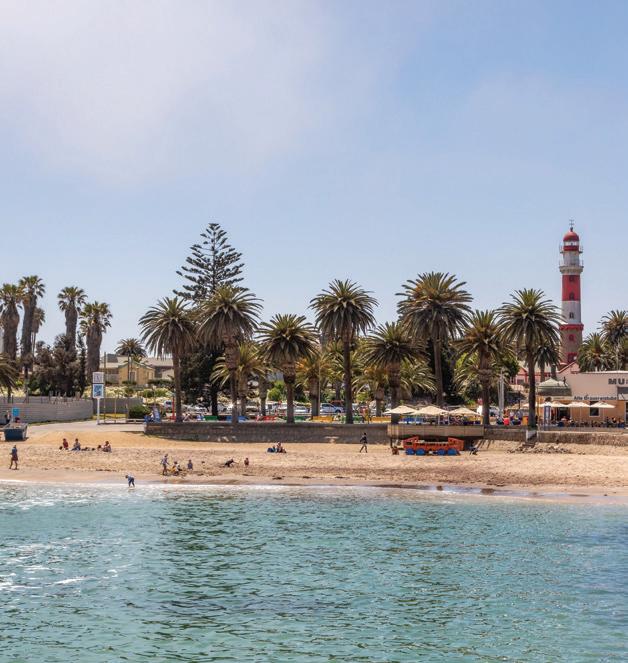
4 minute read
This is Namibia | Discovering the coast
SWAKOPMUND
Swakopmund is much-loved by Namibians as a welcome respite from the heat in the interior. It is also popular among visitors because of its old-world charm and relaxed atmosphere. Founded in 1892 during German colonial rule, it served as the territory’s main harbour for several years.
Today this quaint town between the desert and the sea is enhanced by lush green lawns, elegant palm trees and carefully tended public gardens. It has a wide choice of hotels, guesthouses and restaurants, and several coffee shops selling traditional German cakes and pastries. The coast with its desert hinterland offers many options, both for adventure and for relaxation.
Just before reaching Swakopmund from the interior, enclosed in a small glass-fronted structure, visitors can view the Martin Luther ‘steam-ox’ imported from Germany in 1896 to transport goods between the town and other settlements. When the steam tractor became irretrievably bogged down in the sand, it was dubbed Martin Luther, because of Luther’s historic statement in 1521, “Here I stand, may God help me, I can go no further.” The venue has a museum, toilet facilities and curios for sale.
Quaint architecture from a bygone era adds to the place-outof-time atmosphere of Swakopmund. When approached from the interior, domes, turrets and towers on the skyline appear like a hazy desert mirage. Much of the distinct German colonial character has been preserved and today many of the town’s old buildings house shops, offices and other services.
Another historical landmark is the Old Iron Jetty, originally built in 1911 during the German colonial era. The jetty was frequented especially by anglers and tourists, but gradually fell into disrepair. Major repairs were done in 1983 when 17 pairs of the iron pillars were encased in concrete. In 1997 the Save-theJetty Fund was established and in 1998 the jetty was closed because it was deemed unsafe. Following a major N$ 3.7 million refurbishment in 2006, the front section was reopened to the public. In 2010 the back section was reopened and now includes an oyster bar and restaurant, with an observation deck on top.

SANDWICH HARBOUR
The lagoon at Sandwich Harbour, situated 48 km south of Walvis Bay at the foot of towering ivory-coloured dunes, is a spectacular and sought-after destination. The lagoon, referred to in old texts as Sandfisch Haven, is a former bay that silted up over the years. Today especially ornithologists, photographers and nature lovers visit Sandwich.
The Sandwich area has a strange mystique, enhanced by the legend that buried somewhere in the dunes above the highwater mark is a ship with a rich cargo of ivory, gold and precious stones. This treasure has been searched for by many fortune hunters, but to date has eluded all. The lagoon is fed by fresh water seeping from an inland aquifer, and it is a sanctuary for large numbers of coastal and freshwater birds. It is also an important breeding ground for a variety of fish species. Sandwich Harbour was proclaimed a RAMSAR site in 1995. It is one of five such protected wetlands in Namibia.
Permits to visit Sandwich are obtainable from the MEFT offices in Swakopmund, Walvis Bay, Sossusvlei and Windhoek. Please note that Sandwich is accessible only by 4x4 vehicles; that in certain areas angling and vehicles are prohibited; that angling is not allowed from 25 January to 15 April; and that overnight camping is not allowed here.
WALVIS BAY LAGOON
The Walvis Bay Lagoon takes pride of place as a scenic attraction in the Walvis Bay area. The tranquil body of water, its natural beauty accentuated by thousands of flamingos gathering at the rich feeding grounds, is over 3000 years old. The lagoon has been silting up for hundreds of years, a process hastened by man’s activities. Because of its value nationally and internationally as a wetland area, it was designated as a RAMSAR site in 1995, RAMSAR being a convention on wetlands held in 1971 in Ramsar, Iran. The lagoon is regarded as the most important wetland for coastal birds in Southern Africa. Wading birds including Lesser and Greater Flamingos and White Pelicans are seen here. A pleasant walk of just over 3 km leads to Lover’s Hill, which overlooks the lagoon.
Find more Namibian travel inspiration at www.thisisnamibia.com
Follow @thisis_namibia on Facebook and Instagram for extraordinary Namibia travel stories.
FlyNamibia between Hosea Kutako International Airport and Cape Town, Sossusvlei, Etosha, Twyfelfontein and Swakopmund, as well as between Eros Airport in Windhoek and Ondangwa, Rundu, Katima Mulilo, Lüderitz and Oranjemund.
www.flynam.com










